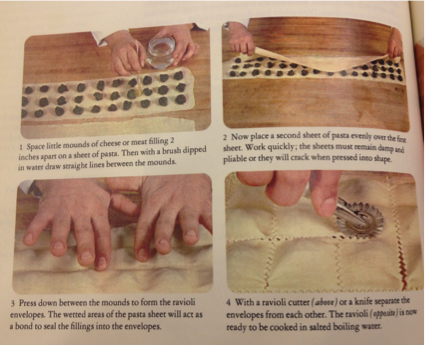PREPARATION
Here is a video of the preparation process.

The following is an in-depth description about the current method (well, current being 1967, but not ancient) for dough folding. While it is a very intricate set of instructions, the action is actually quite systematic and one can see how it goes quickly when making many ravioli at once.
To arrive at the proper consistency, you must knead for ten minutes. Then, “after 10 minutes of kneading, the dough becomes smooth, shiny and elastic.” (Root, Waverly 1968, 44)
“Divide the pasta dough into four pieces and roll out the first one quarter of the dough to make it as thin as possible. Cover the rolled pasta what a damp towel to prevent its drying out, and roll out the second quarter of dough to a similar size and shape. Using the first sheet of rolled-out pasta as a sort of checkerboard, place a mound of about 1 tablespoon of the cheese and egg yolk mixture every two inches across and down the pasta. Dip a pastry brush or your index finger into a bowl of water and make vertical and horizontal lines in a checkerboard pattern on the sheet of pasta, between the mounds of cheese filling. Be sure to use enough water to wet the lines evenly (the water will act as a bond to hold the finished ravioli together). Carefully spread the second sheet of rolled-out pasta on top of the first one, pressing firmly around the filling and along the wetted lines.
With a ravioli cutter, a pastry wheel or a small, sharp knife, cut the past into squares along the wetted lines. Separate the mounds of ravioli and set them aside on wax paper. In the same fashion, roll out, fill and cut the 2 other portions of dough.” (Root, Waverly 1967, 130-131)
While there are some tools mentioned to aid with the process, the formation of each of these little dough pockets is clearly an involved process. It requires attention to each portion of the process, from rolling out the dough to filling it with the appropriately-sized portion to cutting each pocket apart from the others.
